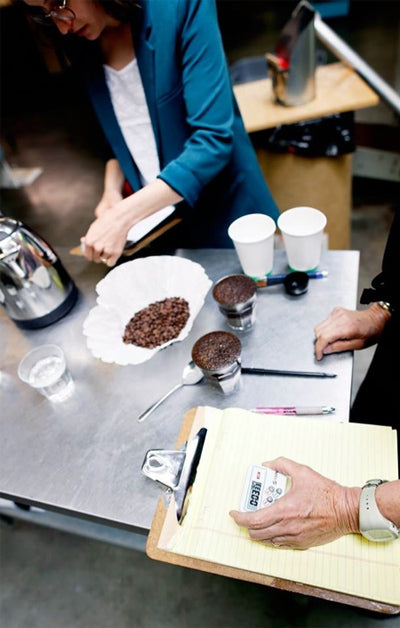
Cupping


Cupping is the formal method by which coffees are systematically evaluated. While it is a professional practice, the equipment used is commonplace and anyone can cup their coffee at home. All you need is a lowball or rocks glass, a spoon (there is actually a specific type of spoon used for cupping which has a round, deep bowl), freshly drawn water brought to a boil (it should be odor-free, but not softened or distilled), and your favorite light- to medium-roasted coffee, ground slightly coarser than for regular filter brewing. The industry standard brewing ratio is 8.25 grams of coffee per 150mL of water, so I'm going to make a very rough conversion here and say that you should use a HEAPING tablespoon of coffee for your 5-6 oz rocks glass. You may also want to have a friend on hand to cup with you, so you can compare notes with each other. Basically, this is how cupping works:
- You put your dry ground coffee in your cup, and examine its color. You sniff the grounds and make notes on the dry fragrance.
- Water is poured over the grounds, but not stirred or agitated in any way. The goal is to form a "crust" on top, which will remain unbroken for three to five minutes. After this time has passed, the crust is broken by stirring three times and allowing the foam to run off the back of the spoon while sniffing the cup. You make notes about the wet fragrance. Then you use a spoon or two to clean the scum off the top of the cup.
- After 8-10 minutes, the coffee should have cooled enough for you to begin tasting. You dip your spoon in and then SLURP the coffee. The goal is to suck the liquid over as much of the palate as possible. Is the coffee sour? Does it taste like apples? Does it taste like wet dog? Does it feel dry or juicy when you move it around in your mouth? At this point, you are judging flavor, aftertaste, acidity, body, and balance. Balance is your opinion of how well that coffee's flavor, aftertaste, acidity, and body work together.
- Keep slurping. Judge the coffee's finish (your impression as the coffee leaves the palate). Make any last notes. Talk to your friend and see what he or she thought.

There is a formal scoring method for cupping, which uses a scale of 1-10. Specialty coffees fall within the 8-10 range. You probably don't need to score your coffee at home, but if you are interested in comparing coffees, you might want to write down notes, because it can be very hard to remember what one coffee tasted like when you're tasting another one—like trying to remember a tune while the radio's blasting.
